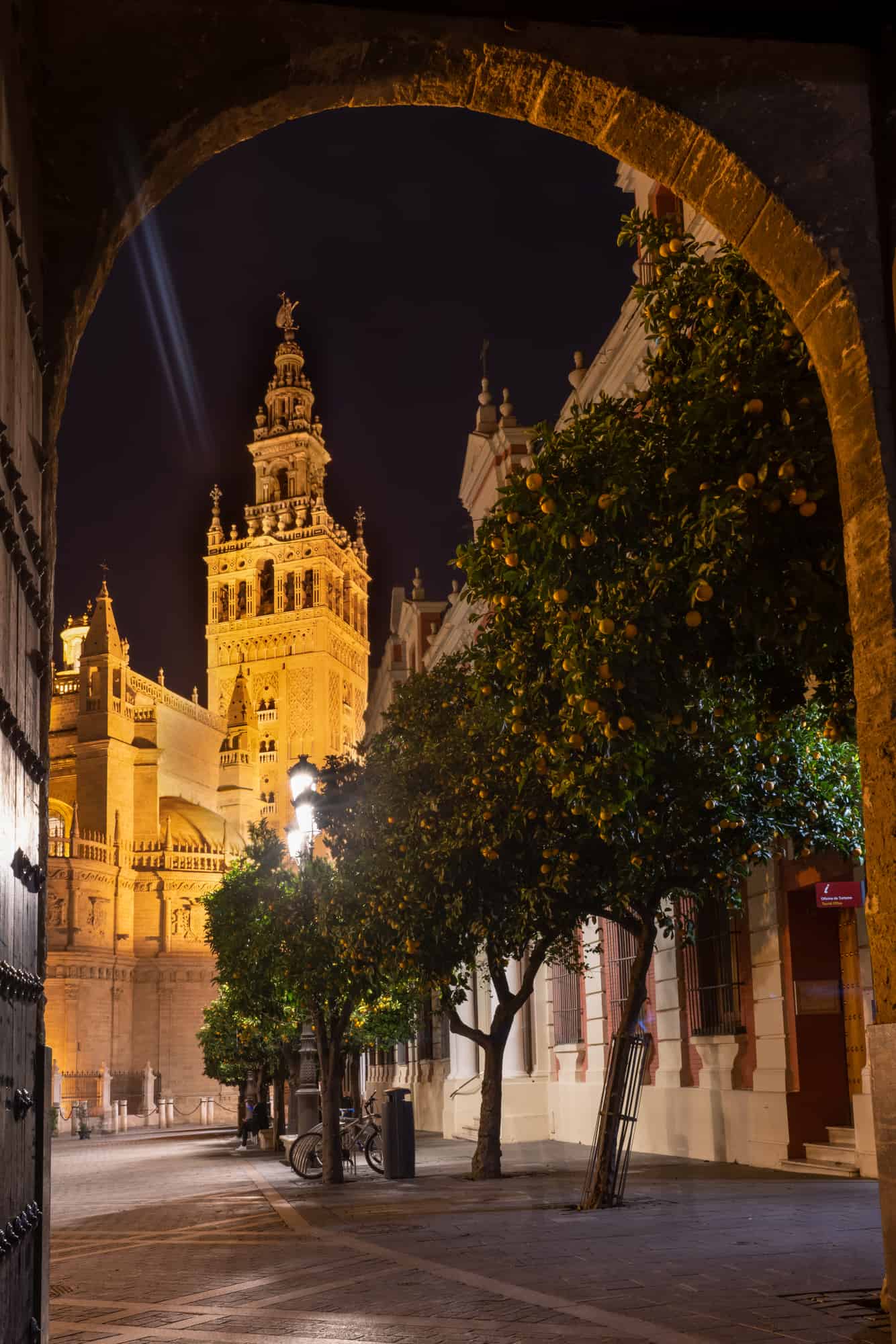How to Experience the Heart of Seville: Tips for an Unforgettable Visit
Seville is one of the three most famous cities across Andalucia, and it is Spain’s third most visited city behind Madrid and Barcelona.
Seville has large elegant plazas, a historical legacy, and picture-perfect cobbled streets. The city is rich with culture and fascinating attractions, including grand monuments, palaces, and traditional flamenco.
If you’re still unsure about planning a visit, in this article, we’ll delve into exactly what makes Seville worth visiting and how you can make the most of your stay in this fascinating city.


Hi, we’re Timon & Filipa!
We travel across Spain and update TravelSpain24 with fresh content, practical tips, and personal stories from the road. Our goal is to help you experience Spain beyond the typical tourist trails.
Top Highlights of Seville

Seville is packed with things to do and see, with limitless opportunities for exploring. Regardless of your interests, Seville has plenty to offer.
Although Seville doesn’t have the coastline that other Andalusian cities boast, it has an old village charm that is unique. The city is also surprisingly lush and green, with beautiful parks and green areas that are perfect for sheltering from the summer heat.
The city also has a river, where you can enjoy boat rides and an amazing atmosphere, whether you’re walking the cobbled streets during the day or enjoying tapas in the evening.
However, there are some must-see highlights that you should incorporate into your itinerary.
Architectural Wonders of Seville
Seville is packed with numerous historical buildings and monuments that provide the architectural wonder of the city. Even if you’re not an architecture buff, there are plenty of iconic landmarks that you should plan for your visit.
The first on your list of must-see landmarks should be the Plaza de España. Although most Spanish cities have a Plaza de España, Seville has one of the most stunning squares in Spain.
The plaza dates back to 1929, and it is an ideal place to wander around, enjoy a drink, or simply sit on one of the lovely tiled benches representing various Spanish cities. The Seville event calendar is also worth checking, as many events are held in the plaza.
It is well worth visiting Seville Cathedral, Europe’s biggest Gothic cathedral, which now has UNESCO World Heritage Site status. The cathedral is impressive from any angle, but there is a tranquil orange courtyard that you can explore. Don’t miss out on climbing the bell tower, La Giralda, to see panoramic views of the city.
Seville also has the Royal Alcazar, which is near Seville Cathedral. This royal palace complex is incredible, with beautiful fountains, lush gardens, and impressive architecture. Just be sure to book your tickets in advance.
Other architectural wonders to fit into your itinerary include the Casa de Pilatos, another smaller palace with impressive rooms in various architectural styles and verdant gardens.
There is also the Setas de Sevilla, or Metropol Parasol, a mushroom-shaped structure you can walk on. This offers amazing views of the city, especially at dawn and sunset.
Seville’s Cultural Essence

Seville has a rich culture that welcomes visitors at any time of the year. The city is known for its festivals and celebrations, particularly during Holy Week at Easter. The Semana Santa celebration has colorful processions and floats carried from the churches to the Santa Maria Cathedral.
However, Seville is also a host for the Biennial of Flamenco Art. Flamenco is the oldest of the traditional dances in Spain, providing a direct way to connect with the city’s culture. Although Flamenco is associated with Spain as a whole, Seville is credited as its birthplace. The dance is hypnotic, deeply moving, and alluring; you can see performances in bars and venues across the city.
Regardless of the occasion, you can immerse yourself in the city’s culture through its vast array of tapas. You can find seasonal and specialty tapas in most venues. Whether you simply call in for a refreshing drink after a morning of sightseeing or want to spend an evening watching a show, you’ll find tapas on offer. What is great is that each venue has its own spin on traditional Seville tapas dishes.
The Natural Beauty Around Seville
Of the most stunning aspects of Seville is its natural beauty. Although Andalucia is typically arid, Seville is actually lush and appealing for nature lovers.
The palaces have lovely gardens, but if you’re seeking tranquility in the city, be sure to visit Maria Luisa Park. This is the most famous park in Seville and has small lakes, fountains, ponds, and wonderful shady spots. The park is right in front of the Plaza de España, making it the perfect spot to relax after the crowds of the plaza.
The Guadalquivir River also runs through Seville, and you can take a boat tour or cruise to get a unique perspective of the city. The tours sail along the river and offer views of monuments, including the Triana neighborhood and the Torre del Oro. You may even pass under the historic Puente de Triana bridge that dates back to 1852.
Although Seville does not have its own beaches, the city is fairly close to some popular beaches if you want to have a beach day during your stay. The closest beaches are in Cadiz, which is approximately an hour and 10 minutes’ drive from Seville. There are also beautiful beaches in Huelva, including Punta Umbria and Matalascañas, less than 90 minutes drive away.
Making the Most of Your Trip to Seville

With so much to see and do in Seville, you’ll want to make the most of your time during your visit. It can be challenging to pack all the famous must-see locations and activities into your itinerary.
Fortunately, there are some tips and tricks that can help you plan your break and ensure that you see all of the highlights that appeal to your interests.
This can include picking the right place to stay, planning your trip for the best time of year, and considering the ideal transportation options.
Ideal Duration for a Seville Visit
There is no easy answer to this question. The number of days you should plan to spend in Seville will depend on what you want to experience in the city and your preferences.
If you’ve only got time for a quick tour of Seville in one or two days, you will be able to focus on a few of the must-see monuments. This includes the Alcazar or the Cathedral and the Plaza de Espana.
You should also have some free time during the day to walk through the Barrio de Santa Cruz, stroll in Maria Luisa Park, and take in the views of the Setas de Sevilla.
Best Times to Visit Seville
Timing can be crucial to enjoying your visit to Seville, so you may wonder about the best and worst times to visit Spain. However, there isn’t a bad time to visit, as every season has different activities.
Deciding the best time to visit Seville will depend on what you want to see and do if you want to avoid the crowds and your weather preferences.
Seville has distinct seasons with different local events that could influence your travel plans. Many people visit Seville in Spring, as the weather is pleasant, and there are the Easter week festivities and the April Ferria. However, this does mean that the city tends to be very busy.
Summer is less busy, but the weather can be brutally hot. So, you’ll need to be prepared for temperatures averaging 36ºc or higher and plan your days to avoid being out during the hottest part of the day.
If you’re a nature lover, you will likely appreciate Seville in Autumn, as the leaves change color and you can explore the vineyards and seasonal tapas. This is a lovely time of year to stroll the parks of the city and the surrounding countryside, as the weather is fairly mild.
However, if you are not seeking the sun, winter in Seville is magical with Christmas markets, street lights, and the Three Kings celebrations. So, think about what you want to see and do in the city to find the ideal time for your visit.
Exploring Seville on Foot

Seville is a very pedestrian-friendly city and is great for those who like to explore on foot. Most of the city is walkable, particularly in the historic city with its quaint cobbled streets and array of cafes and shops. So, if you can pause to refresh yourself anytime during the day, you can enjoy some local tapas and a cool drink.
There are pedestrian-only streets, especially in the Triana district, where you don’t need to worry about traffic, and many of the must-see sights are within a 20-minute walk of the city center.
In fact, if you’re staying near the city center, you should find many monuments, cathedrals, plazas, and parks within effortless reach. This eliminates the need to hire a car or take public transport. However, if you do want a break from walking, you can always try the tourist bus, which meanders around the city.
Seville for the Solo Traveler

Although Seville is very family and couple-friendly, it is also a great place for solo travelers. Since Seville is considered a safe and welcoming city, you don’t necessarily need to have travel companions to have a good time.
The city is beautiful and accessible, with friendly people, a rich history, and incredible food. The tourism infrastructure in the city is excellent, with plenty of tours and attractions for solo travelers. Best of all, since it is pedestrian-friendly, you can meander the streets and find treasures to immerse yourself in the Sevillian culture.
The Perks of Solo Adventures in Seville

Visiting Seville has some perks if you travel alone or like to take on solo adventures. Firstly, it is a small city that is ideal for independent exploration. You can stroll across the city and see many attractions without needing to take a taxi or public transport.
This is great, as you can set your own itinerary and wander around the parks, neighborhoods, and plazas, stopping whenever you feel like a break to enjoy some tapas or a leisurely coffee.
As we touched on above, Seville also has some great accommodation options that are very solo-friendly. For example, if you’re on a budget, you can book a dorm bed and socialize with fellow travelers on the terrace or by the pool. You may even make new friends you keep in contact with after your travels.
Things to Consider When Traveling Solo
Of course, when traveling solo, there are some things that you’ll need to consider. These include:
- Keep a separate coin purse: Seville has talented street performers, particularly in the plazas. You can watch performers, including flamenco dancers, and give them a coin or two in thanks. However, you don’t want to leave yourself vulnerable to pickpockets on a crowded plaza, so carry a separate coin purse and keep your other one secure.
- Be heat aware: The weather in Seville can get very hot. It’s important to recognize the signs of dehydration. Always carry a bottle of water and take breaks during the peak heat hours of the day.
- Book day trips: While you may want to remain independent, you don’t want to miss out on any must-see attractions. So, book some day trips during your stay. There are a number of tourist buses and trips that take you around the city or concentrate on specific attractions. You’ll usually find details of these services at the front desk in your accommodation.
Seville’s Authentic Spanish Flavors
As we touched on earlier, Seville offers some amazing food options, so you can delve into the city’s culinary experience.
If you want to experience as much as possible, look out for the various tapas bars throughout the city. Tapas is usually seasonal, so you’ll see different options at different times of the year.
As in other areas of Spain, tapas and a drink are typical ways to socialize and refresh yourself. Tapas also allows you to try little bites of different dishes. This is a great option if you’re unfamiliar with Spanish cuisine and are unsure what you would like.
Some of the traditional tapas in Seville include Espinacas con Garbanzo, in English, spinach and chickpeas. This traditional dish was influenced by the Moors, who brought chickpeas and cumin with them when they invaded in 711 AD.
Another Seville specialty is Solomillo al Whisky. This is a pork loin and whisky sauce made with garlic and lemon found in many traditional taverns across the city.
Seville also has some spectacular fine dining restaurants where you can enjoy a gourmet feast. Many of these restaurants feature Mediterranean cuisine that has a unique Sevillian twist.

























